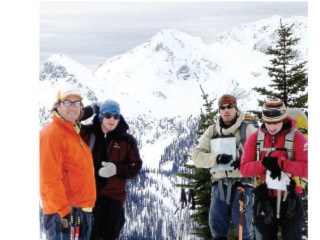When setting out on any backcountry journey, always file a trip plan with a responsible person.
A good day-pack is your first need
You first need a daypack that is 30-45 litres in volume. Find one that has a comfortable and supportive pack belt and sufficiently wide shoulder straps.
Top loading or clamshell styles are most popular for backcountry skiing and snowboarding - most designs have standard features such as small pockets in the lid or inside, compartments for shovel blade/handle/probe /saw, a spacious main compartment, ice axe loop and strap, side compression straps, and a skis/snowboard attachment system.
Fabrics range from super thin and lightweight to more durable and waterproof - for everyday use, durable and waterproof is good! Don’t buy too specific of pack - better it is good for all seasons and activities. Bright colors are easier to spot from a distance in case you’re lost or injured.
Inside your daypack should be:
• Map/compass/GPS (1:50 000 NTS topographic map or better)
• Whistle
• Altimeter watch
• First aid kit and foot care kit
• Multi-tool and knife
• Emergency tarp (silicone-nylon is very light) at least 8X10 ft
• Firestarter/lighter
• Chemical hand warmers
• Headlamp and spare batteries
• Lunch
• Emergency rations such as tea bags/snack bar/candy/nuts - anything that won’t go bad
• Thermos and/or 1.0 liter water bottle
• Pruning/snow saw
• Small repair kit for skis, boots etc....
• VHF radio with local repeater freq. SPOT ME and or a satellite telephone
• Lightweight emergency rescue toboggan
Personal Clothing System:
• “Spare” thick toque, mitts and insulative layer, down jacket or thick prima-loft jacket.
• Waterproof breathable jacket and pants
• Windproof vest or soft-shell jacket
• Sunglasses and goggles
• Neck tube or balaclava
• Lightweight ski helmet
When traveling in avalanche terrain you need avalanche skills TRAINING and:
• Avalanche transceiver (modern 457hz)
• 320 cm avalanche probe (240 cm for the Rockies)
• Avalanche shovel (buy a proper strong metal blade shovel with an extendable handle)
Optional:
• Small canister stove such as a MSR Superfly or Pocket Rocket
• 0.5-liter titanium pot or billy tin
• Small piece of flexible foam pad for sitting on
Upcoming ski weeks and courses:
• AST Level 1, Feb. 19 and 30, Clearwater - $250 inc. transport to field location.
• Introduction to Backcountry Skiing/Boarding, Feb. 21-25 and April 15-21, 2011, North Blue Chalets, Blue River, $800 (includes avalanche safety equipment and AST Level 1 training and certificate). Participants must be strong downhill skiers!
• Glacier Travel Skills for Skiers/ Boarders, April 1-4, Blue River, $500
snowymountain.ca
